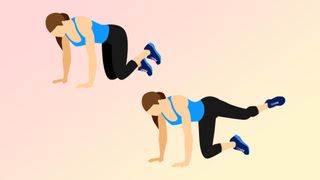I did 100 fire hydrants a day for a week — here's what happened
It might look weird but this move works you like a dog

Some exercises look impressive (lifting weights, for example), some look a little boring (I give you the plank) and some look plain weird — for me, the fire hydrant tops this list. But as I found out, it is a highly effective move. And, I promise you, a tough one.
To find out more about the glutes-gains this exercise promises, I did 50 fire hydrants on each leg (100 in total) every day for a week — read on to find out what happened.
What does the fire hydrant do?
This exercise primarily targets the glutes, helping to strengthen and sculpt these powerful muscles, and it does so with remarkable specificity. Because it works the glutes, it is great for improving hip mobility — extension, rotation, and abduction (moving your leg away from your body). It can be a hard move to perform correctly, but once you get it right you will notice you are also working your core, which you will use for stability. This, in turn, helps keep your lower back in good working order.
Most of us don’t give our glutes the attention they deserve: they are crucial for hip strength, posture, and overall stability. They are also vital for balance, which is not something most of us ever think about. And for you runners out there, bear this in mind: research has shown that strong glutes play a major role in sprint performance.
How to do the fire hydrant
I suggest you use a mat or a soft surface for this move: it’s challenging enough without you having to worry about sore knees.
.
- Start off on all fours, palms flat on the ground, arms straight, and knees under your hips (this is known as tabletop).
- You should be looking down at the floor. Your starting position is crucial, so be sure your back is straight and your core is engaged.
- With your weight evenly distributed between both hands, raise your left leg to the side, keeping your knee at a right angle. How far you can raise your leg will depend on fitness, flexibility, and strength. Aim to raise it to at least an angle of 45 degrees but if you are in good shape and flexible, you may be able to get your thigh almost parallel with the floor.
- Hold for a second and lower. That’s one rep. Start off with 10-20 reps on each side and move up to three sets. Do not strain and stop if you feel any discomfort.

You may find that you are tempted to lean more heavily on your left hand (if you are raising your left leg). Try to maintain a balance between the two hands to maintain proper form (this is not as easy as you might think). You may also find you are opening your hips to the side you are lifting. Address this immediately: concentrate on only raising your leg.
Sign up to get the BEST of Tom’s Guide direct to your inbox.
Upgrade your life with a daily dose of the biggest tech news, lifestyle hacks and our curated analysis. Be the first to know about cutting-edge gadgets and the hottest deals.
I did 50 fire hydrants a day for a week and this is what happened
Day one
That’s 50 on each leg, by the way. That was a lot and, thinking about it, too many. Day one was, not surprisingly, a shock to the system. Maintaining form was a problem — I had to work hard to prevent my non-lifted leg from turning in. And I had to take a break after 30 reps when I was already feeling a deep burn in the sides of my glutes. By 50, I was out of breath — when you are concentrating so much on maintaining form, you forget to breathe evenly. Don’t do as I did. But there was a great moment of levity, too. I was doing the move in my front room. My dog nuzzled the door, padded in, and looked at me in mid-raise as if to say, “If I did that, I’d be in serious trouble. Double standards, man.” Then he left.
Day two
Day two was harder. I should not have been surprised, as I was still feeling the effects of day one. Again, I felt breathless by the end and hours later my glutes were still aware of what I had put them through. This is an intensely targeted move.
Day three
By day three I was finding it easier to maintain form. I’ve done a few of these week-long challenges and once again I noted how quickly the body adapts to a new test. I was still pausing for a breather halfway through, but the afterburn was much less noticeable.
Days four-seven
By day six I’d cracked it. My form was good throughout, I did not have to stop for a breather and I briefly considered pushing for 60 reps. Very briefly. On the final day, I did not even have to think about my body position or breathing. Done.
The most interesting aspect of this exercise is how specific it is. The fire hydrant is focused like a laser on the glutes, especially the gluteus medius and gluteus minimus. Of course, it improves hip mobility but this is not something you will notice as you perform the move.
I found this to be one of the tougher week-long challenges I have undertaken, but it has been well worth the effort. If you are interested in strengthening and toning your glutes or improving your posture, this is a great one. Maybe don’t do it when your dog is in the room.
More from Tom's Guide
John is a writer and editor based in London. He was worked for magazines such as Runner’s World, Men’s Health, Women’s Health and Cosmopolitan. A keen runner, what he lacks in ability he makes up for with enthusiasm and excuses.

